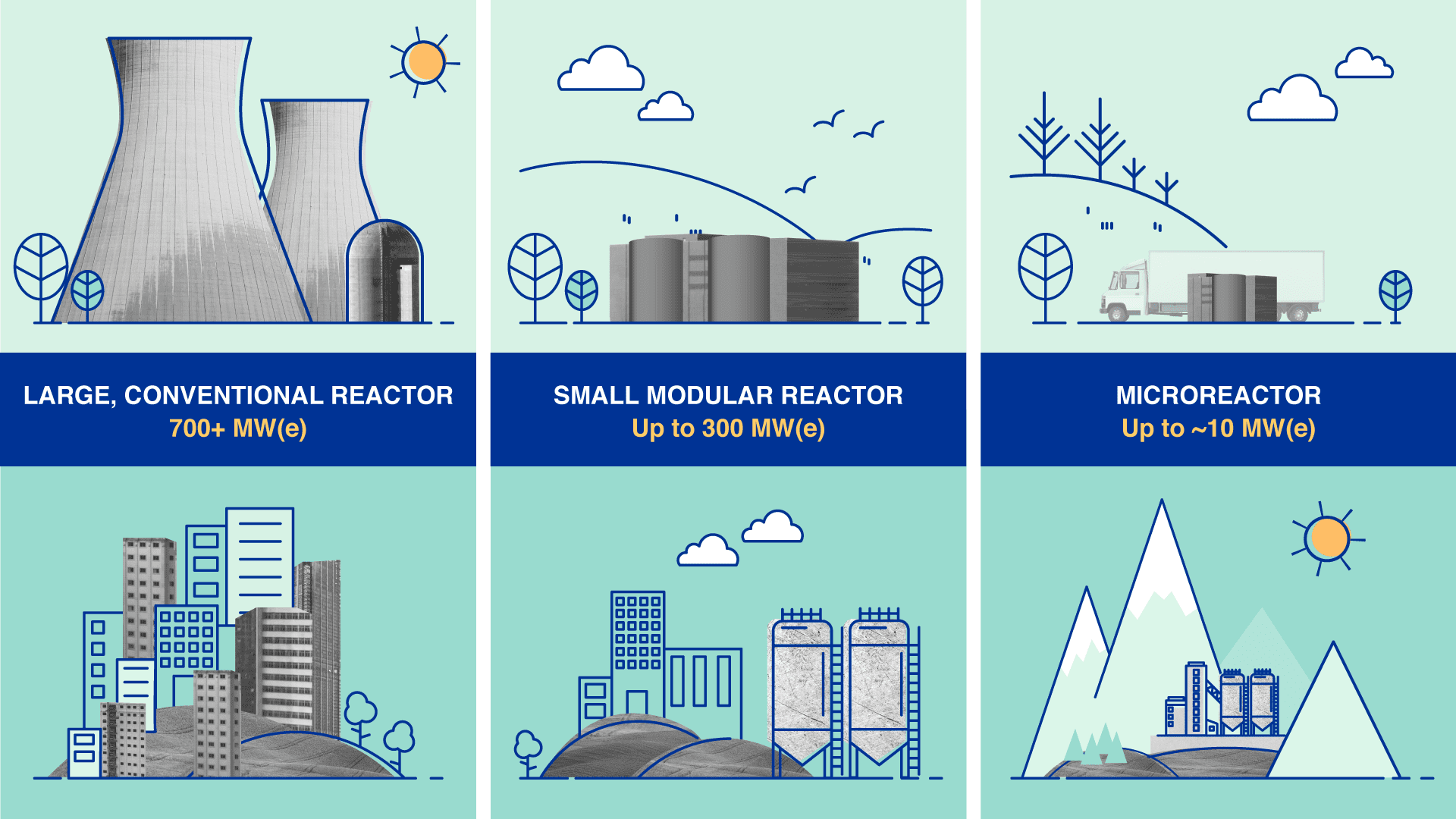
What are Small Modular Reactors (SMRs)?
Small modular reactors (SMRs) have a power capacity of up to 300 MW(e) per unit. Many SMRs, which can be factory-assembled and transported to a location for installation, are envisioned for markets such as industrial applications or remote areas with limited grid capacity. (Image: A. Vargas/IAEA)
Small modular reactors (SMRs) are advanced nuclear reactors that have a power capacity of up to 300 MW(e) per unit, which is about one-third of the generating capacity of traditional nuclear power reactors. SMRs, which can produce a large amount of low-carbon electricity, are:
- Small – physically a fraction of the size of a conventional nuclear power reactor.
- Modular – making it possible for systems and components to be factory-assembled and transported as a unit to a location for installation.
- Reactors – harnessing nuclear fission to generate heat to produce energy.
Learn more about nuclear fission and energy.
Advantages of SMRs
Many of the benefits of SMRs are inherently linked to the nature of their design – small and modular. Given their smaller footprint, SMRs can be sited on locations not suitable for larger nuclear power plants. Prefabricated units of SMRs can be manufactured and then shipped and installed on site, making them more affordable to build than large power reactors, which are often custom designed for a particular location, sometimes leading to construction delays. SMRs offer savings in cost and construction time, and they can be deployed incrementally to match increasing energy demand.
One of the challenges to accelerating access to energy is infrastructure – limited grid coverage in rural areas – and the costs of grid connection for rural electrification. A single power plant should represent no more than 10 per cent of the total installed grid capacity. In areas lacking sufficient lines of transmission and grid capacity, SMRs can be installed into an existing grid or remotely off-grid, as a function of its smaller electrical output, providing low-carbon power for industry and the population. This is particularly relevant for microreactors, which are a subset of SMRs designed to generate electrical power typically up to 10 MW(e). Microreactors have smaller footprints than other SMRs and will be better suited for regions inaccessible to clean, reliable and affordable energy. Furthermore, microreactors could serve as a backup power supply in emergency situations or replace power generators that are often fuelled by diesel, for example, in rural communities or remote businesses.
In comparison to existing reactors, proposed SMR designs are generally simpler, and the safety concept for SMRs often relies more on passive systems and inherent safety characteristics of the reactor, such as low power and operating pressure. This means that in such cases no human intervention or external power or force is required to shut down systems, because passive systems rely on physical phenomena, such as natural circulation, convection, gravity and self-pressurization. These increased safety margins, in some cases, eliminate or significantly lower the potential for unsafe releases of radioactivity to the environment and the public in case of an accident.
SMRs have reduced fuel requirements. Power plants based on SMRs may require less frequent refuelling, every 3 to 7 years, in comparison to between 1 and 2 years for conventional plants. Some SMRs are designed to operate for up to 30 years without refuelling.
Nuclear Power: The Road to a Carbon Free Future
Nuclear power provides 10 per cent of the world’s electricity, but to stem climate change, far greater amounts of clean and reliable energy are needed. Thirty countries currently operate nuclear power plants. More than two dozen others are looking at nuclear energy to meet their power and climate needs. In the western United States, more than 30 towns and cities are also looking to the future. They want to go carbon free, and they are betting on SMRs to get there.
What is the status of SMRs?
Both public and private institutions are actively participating in efforts to bring SMR technology to fruition within this decade. Russia’s Akademik Lomonosov, the world’s first floating nuclear power plant that began commercial operation in May 2020, is producing energy from two 35 MW(e) SMRs. Other SMRs are under construction or in the licensing stage in Argentina, Canada, China, Russia, South Korea and the United States of America.
More than 70 commercial SMR designs being developed around the world target varied outputs and different applications, such as electricity, hybrid energy systems, heating, water desalinisation and steam for industrial applications. Though SMRs have lower upfront capital cost per unit, their economic competitiveness is still to be proven in practice once they are deployed.
Read how international collaboration will help bring SMRs, including microreactors, to fruition.
SMRs and sustainable development
SMRs and nuclear power plants offer unique attributes in terms of efficiency, economics and flexibility. While nuclear reactors provide dispatchable sources of energy – they can adjust output accordingly to electricity demand – some renewables, such as wind and solar, are variable energy sources that depend on the weather and time of day. SMRs could be paired with and increase the efficiency of renewable sources in a hybrid energy system. These characteristics position SMRs to play a key role in the clean energy transition, while also helping countries address the Sustainable Development Goals (SDGs).
Efforts to achieve the target of universal access to energy, SDG 7, has made visible progress; however, gaps are still prevalent, mainly concentrated in remote and rural regions. As global efforts seek to implement clean and innovative solutions, the increased use of renewable energy coupled with the introduction of SMRs has the potential to fill such gaps.
Find out how nuclear can replace coal as part of the clean energy transition.
What is the role of the IAEA?
The SMR Regulators’ Forum, created in March 2015, provides enabling discussions among countries and stakeholders to share SMR regulatory knowledge and experience.
- The IAEA has established the Platform on SMRs and their Applications, a one-stop shop for countries to coordinate support related to all aspects of SMR development, deployment, oversight and their electric and non-electric applications, such as use in district heating and desalination systems.
- The IAEA is assessing the level to which existing IAEA safety standards can be applied to innovative technologies. The IAEA expects to publish a Safety Report on the applicability of IAEA safety standards to SMR technologies in 2022.
- The IAEA’s Technical Working Group on Small and Medium Sized or Modular Reactors (TWG-SMR) and the SMR Regulators’ Forum unites experts to discuss challenges and share experiences related to the development and future deployment of SMRs.
- The IAEA fosters sustainable nuclear energy development. The IAEA hosts technical meetings, produces scientific and technical publications and facilitates coordinated research projects.



